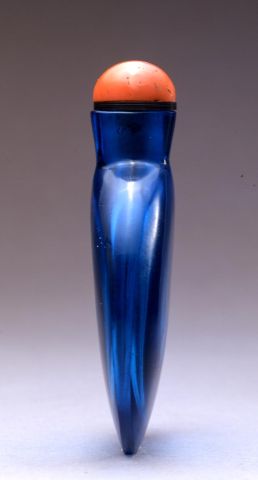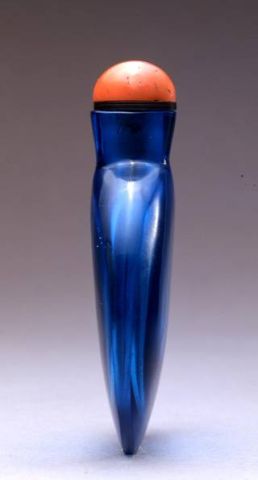

Bottle ID: 00265
BLUE COBALT, TRANSPARENT, ROUND W/FLATTENED SIDES
Date: 1750-1800
Height: 66 mm
Glass, of transparent cobalt-blue, of flattened circular form, with flattened sides, a straight neck and wide mouth, the base slightly concave.
Imperial, attributed to the Palace Workshops, Beijing.
Similar Examples:
Crane Collection nos. 94 and 224.
Moss, Hugh, Victor Graham and Ka Bo Tsang. A Treasury of Chinese Snuff Bottles - The Mary and George Bloch Collection, 2002, Vol. 5, Part 2, pp. 422-423, no. 869.
Moss, Hugh, Victor Graham and Ka Bo Tsang. A Treasury of Chinese Snuff Bottles - The Mary and George Bloch Collection, 1995, Vol. 1, pp. 36-37, no. 11.
Provenance:
Clare Lawrence Ltd.
Alexander Brody
Robert Hall
Richard A. Bourne Co. Inc., Massachusetts, December 14, 1988, lot 87
Mrs. J. Gerald Mayer, no. 603
Exhibited:
Annual Convention ICSBS Toronto, October 2007
Published:
Lawrence, Clare. The Alexander Brody Collection of Chinese Snuff Bottles, 1995, p. 65, no. 94
Brody, Alexander. Old Wine into Old Bottles: A Collector's Commonplace Book, 1993, pp. 84 and 155
Hall, Robert. Chinese Snuff Bottles II, 1989, p. 100, no. 80
The dexterity of the glass blower is very evident in all aspects of this elegant bottle. It stands on two miniature 'feet', formed by its concave base and very narrow (less than 3mm) width. The interior wall almost perfectly mirrors the outer form of the bottle - a complex technical accomplishment in a hand-blown bottle. Finally, the side view of the bottle illustrates how the tapering proportions of the piece combine with its other characteristics to give it an integrity, which is lacking in more mundane examples. This seemingly simple shape becomes even more fascinating when compared to the Bloch Collection example cited above (Bloch no. 11) which is a carved jade example. While of the same form in a different material, the Bloch bottle is outstanding for its rare depth of the pebble's skin which perfectly acts as a 'pouch' for the bottle. Is it any coincidence that both examples, one in glass; the other in jade are uniquely inspirational in their design?
< Back to full list
 English
English 中文
中文